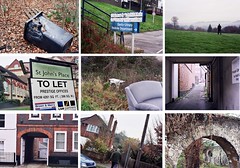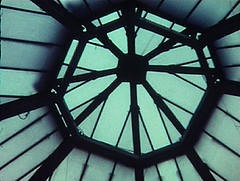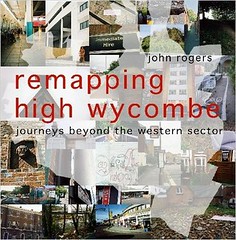Nodules of Energy Walk
The aim of the walk was to find our own boundary of
Wycombe, to go beyond the pre-defined significant
sites of the TCR and also the historic borough
boundary. The inspiration in the end came from Iain
Sinclair, who we heard in conversation at St Luke's
Church in Clerkenwell, London. Sinclair talked about
all the local points of interest near the church such
as the house where Daniel Defoe died and the Hawksmoor
obelisque and described them as 'nodules of energy';
they were his markers in the area.
A quick look at the psychogeography of Wycombe
immediately throws up 'nodules of energy' and they
tend to be situated around the edge of town. You could
imagine them radiating their energy into the urbanised
sprawl inside their vortex. There is the Hill at West
Wycombe topped by the golden ball of St Lawrence's and
marking the spot of the Dashwood Mausoleum, the
Hellfire Caves and more importantly, the site of a
Bronze Age fort. Then there's the earthwork of
Desborough Castle, Tom Burt's Hill, Wycombe Abbey, The
Rye and the Hospital of St John. The outer tip of the
loop is marked by Hughenden with its church, dragon
myth and monument to Benjamin Disraeli.
Our walk was an attempt to join them up, to see how
the town would look from the outside, to somehow
rediscover the origins that led to it being here in
the first place. A walk back to the beginnings of High
Wycombe.
The start point was the home of Dr Martin Lluelyn,
poet and doctor to Charles I & II. I read a verse from
one of his eulogies to Charles II. It was a busy
Saturday. I stood outside Don Miguel's Men's
Hairstylists and people walked past me without batting
an eyelid as if it was a normal event. I hoped to stir
Lluelyn's slumbering spirit.
I rendezvous with Dad at the site of the ruins of the
Hospital of St John. He attended the site behind when
it was the Tech.
Onto the Rye, we'll only touch this side as a symbolic
gesture but in the short stretch of path that leads to
Wycombe Abbey. In the upper boughs of a tall oak
mistletoe grows in great dark clusters, "an invader"
the old chap says. I note the pagan connotations of
oak and mistletoe entangled, as there was a pagan spot
of well worship on the other side of the Rye.
It's depressing to see that the old Wanderers ground
of Loakes Park is now just a car park. What heroism
took place under that concrete; Bodger Horseman's 60
goals in the 1965-66 season (Dad's cousin via his Mum,
Florence Horseman), and the 0-0 draw with Jack
Charlton's First Division Middlesborough in the FA
Cup.
Tom Burt's Hill takes its name from the fella who
reputedly found a crock of gold there when grubbing
around in the undergrowth. It marks a nodule of energy
as it sits on a ley line that we'll now more or less
follow to West Wycombe. Dad finds the lone beech tree
people used to watch the football from, walk from
Flackwell Heath, watch the game then walk home without
spending a penny.
We stop at the corner to admire Desborough Castle. It
stands out unmistakably from the council estate
opposite. The trenches of the castle are littered with
beer cans and take-away containers. There's a melted
wheelie bin in the centre continuing the theme of
burnt objects along the ley-line.
We look out to see West Wycombe Hill still clouded in
mist. It's our next stop. I think of the verses of
poetry by Ivor Gurney that I've written out on a torn
up piece of paper: "What must High Wycombe hills look
like now!/ Great clouds of miraculous green, / green
that looks alive / and gifted with a voice.
It is a delectable land all this, / with changing
soils in the valley / and a happy air of peace over
all".
There was a top secret communications network called
'Backbone' that planned to have a radio mast in these
hills. There were suggestions that the Backbone
stations coincided with ley-lines.
A Wycombe Wanderers supporter complete in club hat and
scarf swigging a can of Stella stomps up the path.
"Will the pubs be open in West Wycombe?" we ask.
"Better pull your finger out", he advises, "Village
pubs remember keep different hours". We can't be more
than two miles from urban Wycombe and the pubs have
different opening hours.
We feel almost euphoric by the end. The walk felt
epic. At several points we told people the purpose of
our walk. In suburban streets Dad explained that we
were retracing the ancient footpaths of Wycombe and
drew slightly bemused expressions. Nearing West
Wycombe people couldn't see how we'd walked through
from the Rye, to here?
The town has built up around these tracks but not
erased them completely. Whilst the traffic chokes and
suffocates the byways the footpaths transport the
walker through ancient beechen groves to sites of
arcane significance.
The walk became an act; an act of remembering how we
came to end up in this verdant valley and the power it
still has to transport us from our quotidian town
lives.
We will re-create this walk, doing the full circuit on the Summer Solstice 2005 taking in the Holy Well on the Rye and extending the route up into the Hughenden Valley. Please email us for more information: wycombederive@yahoo.com
Labels: iain sinclair, nodules of energy, psychogeography




